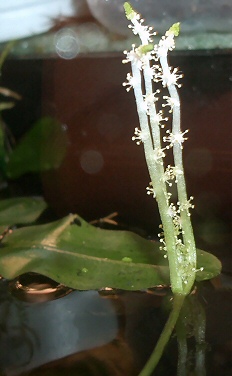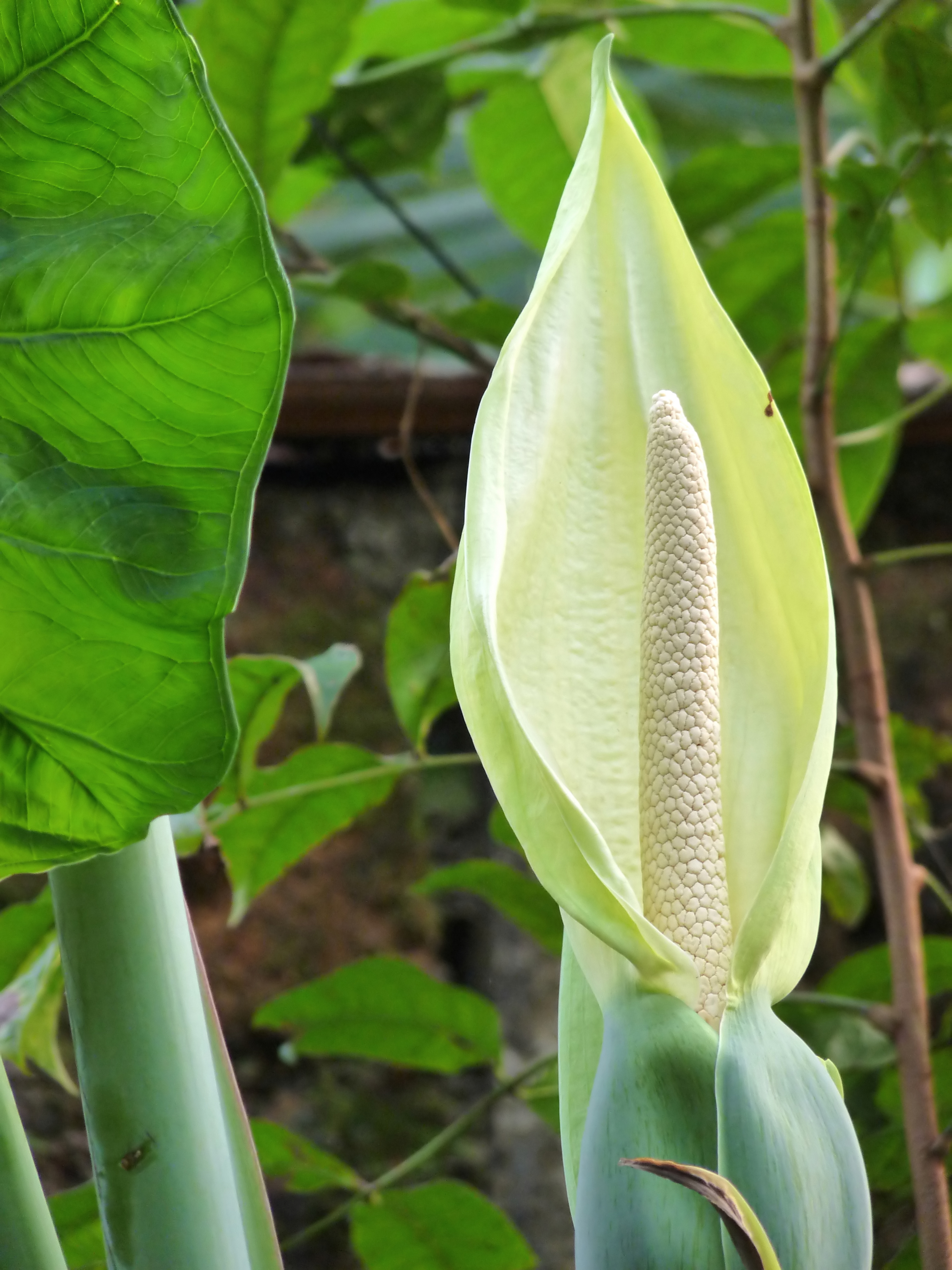|
Perforate Leaf
Perforate leaves, sometimes called fenestrate, occur naturally in some species of plants. Holes develop as a leaf grows. The size, shape, and quantity of holes in each leaf can vary greatly depending on the species and can even vary greatly within a given species. Perforation is caused by sections of leaf ceasing cell growth or by dying during an early stage in the development of the leaf. These deformations that are created earliest in the leaf development end up looking more like slashes whereas those that develop later end up looking more like holes. This trait is found in only one species in Aponogetonaceae, Aponogeton madagascariensis (Madagascar laceleaf), and a few genera in Araceae, particularly Monstera. It is not fully known what evolutionary purpose perforation serves, but there are several possibilities. Perforation could serve the purpose of reducing the variations in growth rate, minimize chances of leaves tearing in high winds or it could help to maximize the amount ... [...More Info...] [...Related Items...] OR: [Wikipedia] [Google] [Baidu] |
Monstera Deliciosa3
''Monstera'' is a genus of 59 species of flowering plants in the arum family, Araceae, native to tropical regions of the Americas. Etymology The genus is named from the Latin word for "monstrous" or "abnormal", and refers to the unusual leaves with natural holes that members of the genus have. Description Growth pattern They are herbs or evergreen vines, growing to heights of in trees, climbing by means of aerial roots which act as hooks over branches; these roots will also grow into the soil to help support the plant. Since the plant roots both into the soil and over trees, it is considered a hemiepiphyte. Leaves The leaves are alternate, leathery, dark green, very large, from long (up to long in ''M. dubia'') and broad, often with holes in the leaf blade. The fenestrated leaves allow for the leaves to spread over greater area to increase sunlight exposure, and to allow light to reach other leaves below, by using less energy to produce and maintain the leaves. ... [...More Info...] [...Related Items...] OR: [Wikipedia] [Google] [Baidu] |
Fenestrate
Fenestration may refer to: * Fenestration (architecture), the design, construction, or presence of openings in a building * Used in relation to fenestra in anatomy, medicine and biology * Fenestration, holes in the rudder of a ship to reduce the work required to move it while preserving its ability to steer See also * Defenestration Defenestration (from Modern Latin ) is the act of throwing someone or something out of a window. The term was coined around the time of an incident in Prague Castle in the year 1618 which became the spark that started the Thirty Years' War. Th ..., the act of throwing someone or something out of a window * National Fenestration Rating Council, an organization which measures and compares the energy performance of fenestration products {{disambiguation ... [...More Info...] [...Related Items...] OR: [Wikipedia] [Google] [Baidu] |
Aponogetonaceae
The Aponogetonaceae (the Cape-pondweed family or aponogeton family) are a family of flowering plants in the order Alismatales. In recent decades the family has had universal recognition by taxonomists. The APG system (1998) and APG II system (2003) treat it in the order Alismatales in the clade monocots. The family consists of only one genus, ''Aponogeton'', with 56 known species (Christenhusz & Byng 2016 ) of aquatic plants, most of which have been included in a molecular phylogeny by Chen et al. (2015). The name was published in '' Supplementum Plantarum'' 32: 214 (1782) and is derived from a geographic location neighboring (''geton'') the Apono tribal district of coastal Gabon. Some species are used as ornamental plants in aquariums. Distribution They are aquatic plants, which are found in tropical to warm temperate regions of Africa, Asia and Australasia.Watson, L. & Dallwitz, M. J. (1992 onwards)Aponogetonaceae ''Aponogeton distachyos'' is originally from South Africa but h ... [...More Info...] [...Related Items...] OR: [Wikipedia] [Google] [Baidu] |
Aponogeton Madagascariensis
''Aponogeton madagascariensis'' is commonly known as Madagascar laceleaf, lattice leaf or lace plant. It is an aquatic plant native to Madagascar, popularly sold for use in aquariums. It is endangered in the wild. Description It is an aquatic monocotyledonous perennial plant with tuberous rhizomes in diameter. The leaves are oblong, the leaf blade 15–55 cm long and from 5–16 cm broad, with a total leaf length including the petiole of up to . The leaves spread horizontally beneath the surface of the water, and are little more than a lattice-like skeletal network of veins with no tissue between. The flowers are produced on an erect spike up to long, protruding up to above the water surface. There seem to be several forms of this plant in cultivation, some large, some much smaller. Cultivation and uses The tuberous roots are edible. It requires water temperatures of 15-26 °C and pH of 5-7.5, growing best in low light outdoors.Tropica''Aponogeton madagasc ... [...More Info...] [...Related Items...] OR: [Wikipedia] [Google] [Baidu] |
Araceae
The Araceae are a family of monocotyledonous flowering plants in which flowers are borne on a type of inflorescence called a spadix. The spadix is usually accompanied by, and sometimes partially enclosed in, a spathe (or leaf-like bract). Also known as the arum family, members are often colloquially known as aroids. This family of 140 genera and about 4,075 known species is most diverse in the New World tropics, although also distributed in the Old World tropics and northern temperate regions. Many species display very decorative leaves and flowers, and they are widely used for gardening; popular as indoor plants and also outdoor plants where climates are mild, and winter freezes will not generally occur. However, some temperate species are also very popular in Mediterranean-climate gardening, or in moderately cool temperate zones, such as ''Zantedeschia''. Description Species within Araceae are often rhizomatous or tuberous, and the leaves nearly always contain calcium oxa ... [...More Info...] [...Related Items...] OR: [Wikipedia] [Google] [Baidu] |
Monstera
''Monstera'' is a genus of 59 species of flowering plants in the arum family, Araceae, native to tropical regions of the Americas. Etymology The genus is named from the Latin word for "monstrous" or "abnormal", and refers to the unusual leaves with natural holes that members of the genus have. Description Growth pattern They are herbs or evergreen vines, growing to heights of in trees, climbing by means of aerial roots which act as hooks over branches; these roots will also grow into the soil to help support the plant. Since the plant roots both into the soil and over trees, it is considered a hemiepiphyte. Leaves The leaves are alternate, leathery, dark green, very large, from long (up to long in ''M. dubia'') and broad, often with holes in the leaf blade. The fenestrated leaves allow for the leaves to spread over greater area to increase sunlight exposure, and to allow light to reach other leaves below, by using less energy to produce and maintain the leaves. ... [...More Info...] [...Related Items...] OR: [Wikipedia] [Google] [Baidu] |
Hemiepiphyte
A hemiepiphyte is a plant that spends part of its life cycle as an epiphyte. The seeds of primary hemiepiphytes germinate in the canopy and initially live epiphytically. They send roots downward, and these roots eventually make contact with the ground. Secondary hemiepiphytes are root-climbers that begin as rooted vines growing upward from the forest floor, but later break their connection to the ground. When this happens, they may send down long roots to the ground.Mayo et al. "Araceae" in Kubitzki (1998b ''The families and genera of vascular plants''): "The root climbers and hemiepiphytes normally grow in humid forests, often very high in the canopy. When losing connection with the forest floor, they may send down long roots to the ground; such plants may be referred to as secondary hemiepiphytes. Hemiepiphytes and root climbers cling tightly to the bark of the host with negatively phototropic roots. Skototropism, an orientation movement towards a well-defined dark area, ha ... [...More Info...] [...Related Items...] OR: [Wikipedia] [Google] [Baidu] |
Aroids
The Araceae are a family of monocotyledonous flowering plants in which flowers are borne on a type of inflorescence called a spadix. The spadix is usually accompanied by, and sometimes partially enclosed in, a spathe (or leaf-like bract). Also known as the arum family, members are often colloquially known as aroids. This family of 140 genera and about 4,075 known species is most diverse in the New World tropics, although also distributed in the Old World tropics and northern temperate regions. Many species display very decorative leaves and flowers, and they are widely used for gardening; popular as indoor plants and also outdoor plants where climates are mild, and winter freezes will not generally occur. However, some temperate species are also very popular in Mediterranean-climate gardening, or in moderately cool temperate zones, such as ''Zantedeschia''. Description Species within Araceae are often rhizomatous or tuberous, and the leaves nearly always contain calcium oxalate ... [...More Info...] [...Related Items...] OR: [Wikipedia] [Google] [Baidu] |
Leaf Window
Leaf window, also known as epidermal window, and fenestration. is a specialized leaf structure consisting of a translucent area through which light can enter the interior surfaces of the leaf where photosynthesis can occur. The translucent structure may include epidermal tissue, and in some succulent plants it consists of several cell layers of parenchyma, which may also function as water-storage tissue. It can appear as a large continuous patch, a variegated or reticulated region, or as numerous small spots. Is found in some succulent plants native to arid climates, allowing much of the plant to remain beneath the soil surface where it is protected from desiccation by winds and heat while optimizing light absorption. Many species featuring leaf windows are native to Southern Africa. Functions The primary function of the translucent windows is to increase the absorption of radiant energy, and thereby the rate of photosynthesis. Epidermal windows are commonly situated at the apex of ... [...More Info...] [...Related Items...] OR: [Wikipedia] [Google] [Baidu] |
Leaves
A leaf (plural, : leaves) is any of the principal appendages of a vascular plant plant stem, stem, usually borne laterally aboveground and specialized for photosynthesis. Leaves are collectively called foliage, as in "autumn foliage", while the leaves, stem, flower, and fruit collectively form the shoot system. In most leaves, the primary photosynthesis, photosynthetic tissue is the palisade mesophyll and is located on the upper side of the blade or lamina of the leaf but in some species, including the mature foliage of ''Eucalyptus'', palisade mesophyll is present on both sides and the leaves are said to be isobilateral. Most leaves are flattened and have distinct upper (Glossary of botanical terms#adaxial, adaxial) and lower (Glossary of botanical terms#abaxial, abaxial) surfaces that differ in color, hairiness, the number of stomata (pores that intake and output gases), the amount and structure of epicuticular wax and other features. Leaves are mostly green in color due ... [...More Info...] [...Related Items...] OR: [Wikipedia] [Google] [Baidu] |
Plant Morphology
Phytomorphology is the study of the morphology (biology), physical form and external structure of plants.Raven, P. H., R. F. Evert, & S. E. Eichhorn. ''Biology of Plants'', 7th ed., page 9. (New York: W. H. Freeman, 2005). . This is usually considered distinct from plant anatomy, which is the study of the internal Anatomy, structure of plants, especially at the microscopic level. Plant morphology is useful in the visual identification of plants. Recent studies in molecular biology started to investigate the molecular processes involved in determining the conservation and diversification of plant morphologies. In these studies transcriptome conservation patterns were found to mark crucial ontogenetic transitions during the plant life cycle which may result in evolutionary constraints limiting diversification. Scope Plant morphology "represents a study of the development, form, and structure of plants, and, by implication, an attempt to interpret these on the basis of similarit ... [...More Info...] [...Related Items...] OR: [Wikipedia] [Google] [Baidu] |






.png)
